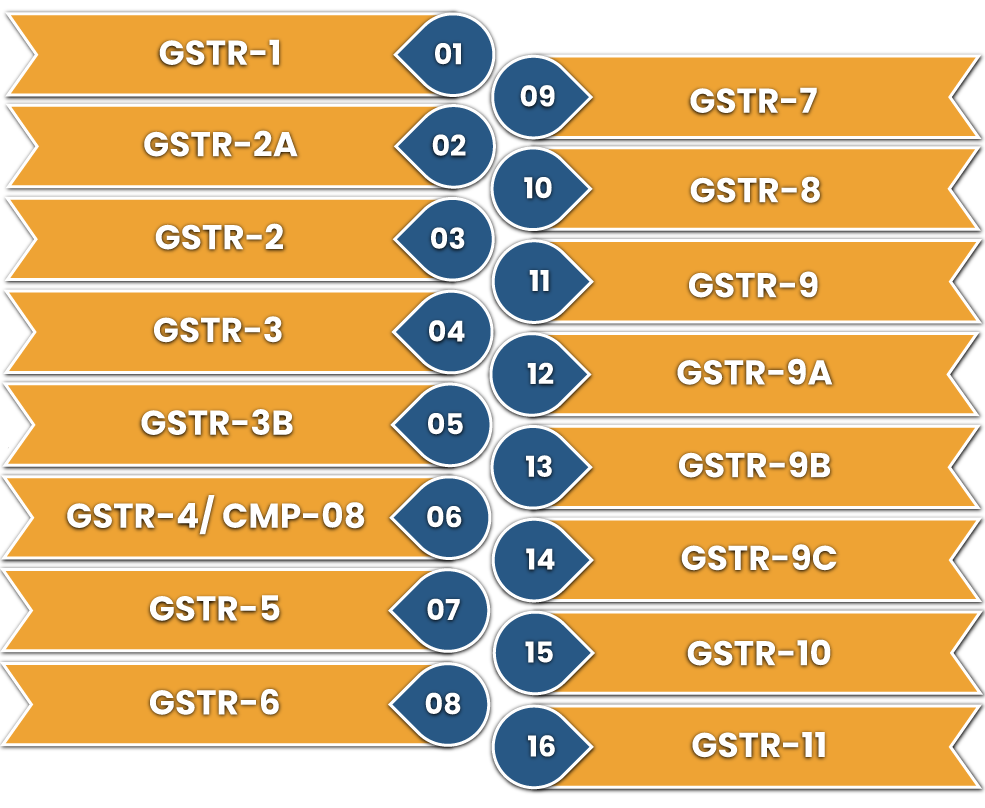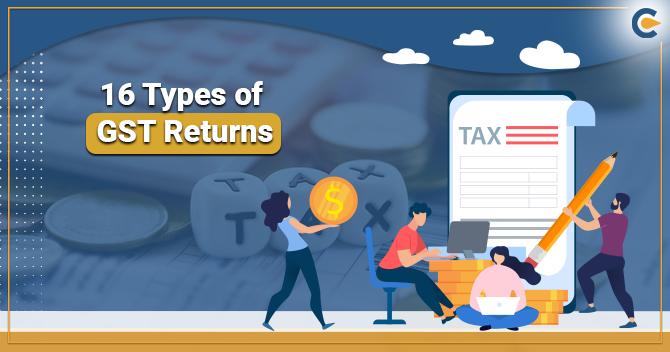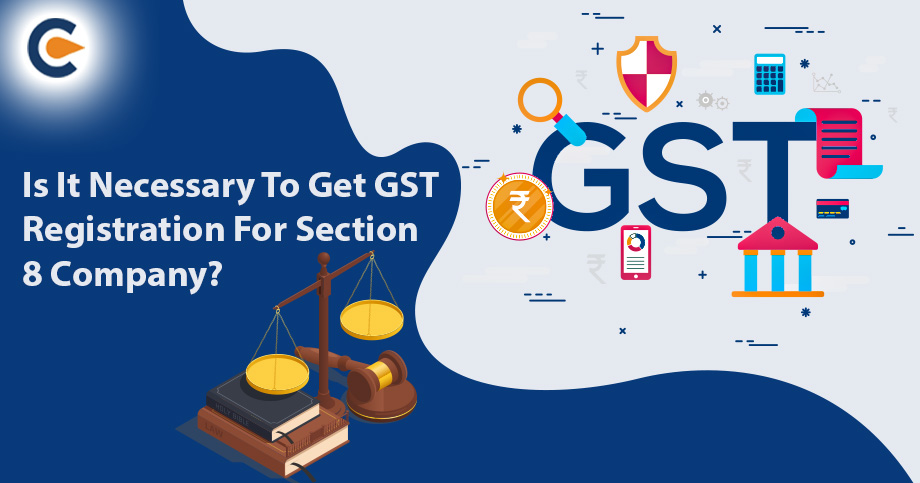The GST registration is immensely reliant on the regulatory regime of the undertaking and the agreements between multiple business dealers and holders listed on the GST website. The GST return records will include items such as acquisition, selling, purchase tax (input tax), and local taxes (sales tax) as follows (output tax).
When filing GST returns, one would have to pay the subsequent tax obligation amount (amount loaned to the govt). In this blog, we are going to explain the types of GST Return. Indian taxpayers and companies have to file such returns with the state to update the invoices correctly.
These returns must be compulsory since any failure to comply with them may lead to the denial of the Input Tax Credit, apart from the attraction of interest and penalties, etc. A compulsory mechanism for a seamless flow of credit to the last beneficiary is the correct filing of details and passing it on in the refunds. The returns are planned so that all transactions are in harmony with each other, and no trade between the buyers and sellers is left unsupervised.
Read our article:GST Return Filing Procedure – Types of GST Returns, Due Date and Penalty
What are the Types of GST Return available?
There are 16 types of GST Return available as follows-


GSTR-1 (Return for Outward Supplies)
GSTR-1 is one of types of GST return that is required to be provided for reporting details related to outward supplies of goods and services made. In other words, sales transactions made during a tax period as well as for reporting any issued debit and credit notes. Any amendments made to sales invoices, even related to previous tax periods has to be reported in the Form GSTR-1.
GSTR-1 is required to be filed by all usual taxpayers who are listed under GST. It has to be filed monthly, excluding the case of small taxpayers whose turnover is up to INR 1.5 crore in the preceding financial year, they can file this type of GST Return on a quarterly basis.
GSTR-2A (Read-Only Return of ITC)
GSTR-2A is the return consisting of details of all internal supply of goods and services that is purchases made from any registered suppliers during taxation period. The data is auto-populated based on information filed by the suppliers in their Form GSTR-1. GSTR-2A is a read-only return and no action can be initiated.
GSTR-2 (Return of Inward Supplies)
GSTR-2 is one of types of GST return that is furnished for the inward supplies of Goods and Services that is relevant to the purchases made during a particular taxation period. The information in the GSTR-2 return are auto-populated from the GSTR-2A. Different from GSTR-2A, the GSTR-2 return can be amended.
GSTR-2 is required to be filed by all normal taxpayers listed under GST. Still, the filing of the same has been postponed ever since the commencement of GST.
GSTR-3 — (Return Abbreviated for ITC and Outward)
GSTR-3 is a monthly return for providing summarized details for all inward supplies received, outward supplies made, and Input Tax Credit claimed, along with information of the tax liability as well as taxes paid. This return is auto-generated, based on the GSTR-1 and GSTR-2 filed.
GSTR-3 is required to be filed by all normal taxpayers who are registered under GST. Still, filing of the same return has been postponed ever since the commencement of GST.
GSTR-3B (Synopsis of Inward & Outward Supplies)
GSTR-3B is a scheduled self-declaration to be filed monthly, for providing summarized information of all outward supplies made, claimed input tax credit, tax liability determined and taxes that are paid. GSTR-3B is required to be filed by all normal taxpayers listed under GST.
GSTR-4 / CMP-08 (Return of Composition Scheme)
GSTR-4 is one of types of GST return that is required to be filed by taxpayers who have selected for the Composition Scheme under GST. CMP-08 is the return that has replaced the former GSTR-4.
The Composition Scheme is a system in which taxpayers with annual turnover up to INR 1.5 crores pay taxes at a fixed rate on the confirmed turnover. The CMP-08 return is required to be filed on a quarterly basis.
GSTR-5 (Return of a Non-Resident Taxpayer)
GSTR-5 is the return filed by non-resident taxpayers, who are listed under GST and carry out their business dealings in India. This return consists if details of all inward supplies received, outward supplies, credit or debit notes, tax liability as well as paid taxes.
The GSTR-5 return is required to be filed monthly for each month that the taxpayer is listed under GST in India.
GSTR-6 (Return from Input Service Distributors)
GSTR-6 is a monthly return that is required to be filed by Input Service Distributor. It will consists of details regarding input tax credit received and distributed by the Input Service Distributor. It will also contain details of all documents issued for the circulation of input credit and the way of distribution.
GSTR-7 (Return for Taxpayers Deducting TDS)
GSTR-7 is a monthly return that is required to be filed by individuals who need to deduct TDS (Tax deducted at source) under GST.
GSTR 7 will consists of details related to TDS deducted, TDS liability payable and claimed TDS refund.
GSTR-8 (Return for E-Commerce Operators TCS)
GSTR-8 is a monthly return that is required to be filed by E-Commerce Operators listed under the GST who needs to collect Tax collected at Source (TCS).
GSTR-8 will consist details of all purchases made from the E-commerce platform, and the TCS accumulated.
GSTR-9 (Annual Return for Normally Registered Taxpayer under GST)
GSTR-9 is the annual return that is required to be filed by taxpayers listed under GST. It consists of details regarding all outward supplies made, inward supplies received during the applicable previous year.
This return is filed under different tax heads such as CGST, SGST and IGST as well as HSN codes. Along with information of taxes payable. It is a mixture of all the monthly or quarterly returns such as GSTR-1, GSTR-2A, and GSTR-3B filed during that particular financial year.
GSTR-9 is obligatory to be filed by all taxpayers listed under GST*, excluding taxpayers who have chosen for the Composition Scheme, Input Service Distributors, Casual Taxable Individuals, Non-resident Taxable Individuals and persons paying TDS according to Section 51 of CGST Act[1].
*According to the CBIC notification 47/2019, the annual return under GST for taxpayers having an annual turnover that does not exceed INR 2 crores has been made discretionary for Financial Year 2017-18 and Financial Year 2018-19.
GSTR-9A (Annual Return under Composition Scheme)
GSTR-9A is the annual return required to be filed by taxpayers who have already registered under the Composition Scheme in a financial year*. It is a mixture of all the quarterly returns that is filed during that particular financial year.
*GSTR-9A annual return for Composition taxpayers has been renounced for Financial Year 2017-18 and Financial Year 2018-19 according to the verdict in the 27th GST Council meeting.
GSTR-9C (Return for obtaining Accounts Auditing from CA)
GSTR-9C is one of types of GST return in which the settlement statement that is required to be filed by all taxpayers listed under GST whose aggregate turnover exceeds INR 2 crores in a particular financial year. The registered individual has to get their accounts audited by a Chartered Accountant. The statement of settlement is the examined financial statements of the taxpayer and the annual return GSTR-9 that has been filed by that particular individual.
GSTR-9C is required to be filed for every GSTIN, henceforth, one PAN can have numerous GSTR-9C forms filed. According to the CBIC notification 16/2020, GSTR-9C is renounced for the taxpayers with an annual turnover of more than INR 5 crores for the year 2018-19.
GSTR-10 (Return for the Person whose Registration gets Rescinded)
GSTR-10 is one of types of GST return that is required to be filed by any taxable person whose registration has been cancelled or surrendered. This return is also known as a final return and is required to be filed within 3 months from the date of cancellation or order of cancellation, whichever is former.
GSTR-11 (Return for UIN Holders)
GSTR-11 is one of types of GST return that is required to be filed by individuals who have been issued a Unique Identity Number (UIN) to get a refund under GST for the goods and services procured by them in India.
UIN is a categorization made for foreign diplomatic assignments and embassies that are not liable to pay tax in India. GSTR-11 will consist of details of inward supplies received and claimed refund.
Conclusion
GST return filing process in India can be a complicated affair. Understanding the purpose of each return is necessary to understand return filing liability of taxpayers which is relevant. Every business registered under GST needs to file GST Returns containing the details of the profits they earned in the preceding year and other necessary information prescribed by law. However, we should be transparent about the above basic data related to Types of GST return in India.
Read our article:CBIC: Extension of deadline for GST Return Filing FY 2019-20











